Nanobody precision & abberior STAR brilliance
A perfect STED pair
New FluoTag®-X4 anti-GFP nanobodies and Smart Secondaries® with abberior STARs
In collaboration with NanoTag Biotechnologies, we’re proud to introduce a new line of imaging reagents that combine high-quality single-domain antibodies (sdAbs, nanobodies) with our abberior STAR dyes, optimized for STED and confocal microscopy.
Customer favorites abberior STAR 460L, STAR GREEN, STAR ORANGE and STAR RED are now available conjugated to biclonal FluoTag®-X4 anti-GFP, monoclonal FluoTag®-X2 anti-mouse IgG1, and FluoTag®-X2 anti-rabbit secondary nanobodies (Smart Secondaries®) offering exceptional brightness, photostability, and localization precision – perfect for high-resolution imaging.
Together, abberior and NanoTag Biotechnologies deliver imaging reagents that outperform conventional antibodies—uniting smart monoclonal sdAb binders with brilliant dyes for unmatched imaging precision:
Smart Secondaries® for species-independent multiplexing
Smart Secondaries® are a new generation of secondary single-domain antibodies (sdAbs, nanobodies) that bind conventional immunoglobulins with unmatched species and isotype specificity. But they’re more than just precise — they unlock powerful possibilities like true one-step indirect immunofluorescence and effortless species-independent multiplexing.
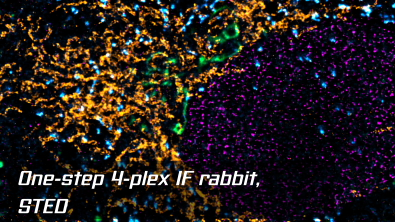
Optimal solution for detecting GFP-tagged proteins
The combination of super-bright, highly photostable abberior dyes and ultra-specific FluoTag-X4® anti-GFP nanobodies from NanoTag Biotechnologies provides an outstanding solution for high-resolution imaging — perfect when small labels, deep tissue penetration, and exceptional specificity are critical.
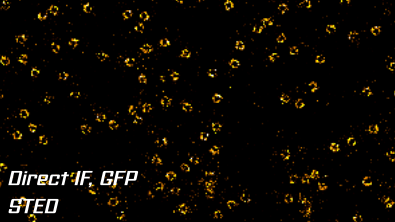
New FluoTag® sdAb (nanobodies) available now!
Explore all anti-GFP variants here!
Explore all anti-mouse IgG1 variants here!
Explore all anti-rabbit IgG variants here!
Check out the related protocols!
Why choose single-domain antibodies coupled to abberior STARs?

Nanobodies for highest specificity
Smart Secondaries® and anti-GFP bind only what you need — no cross-reactivity, no noise.

4 fluorophores per target for superior signal intensity
abberior STAR 460L, GREEN, ORANGE, RED: Bright, photostable, and perfectly matched to your high-end setup — from widefield to STED.

Tiny size (3 nm) for efficient labeling of thick specimens
Single-domain antibodies seamlessly penetrate dense tissues and tight compartments, reducing artifacts, minimizing linkage errors and improving contrast.

Direct & indirect IF compatibility
Anti-GFP for one-step staining. Smart Secondaries® for effortless multiplexing.

Ethically sourced and animal-free recombinant expression
All stages of development and production take place in Germany—from alpaca immunization at NanoTag Biotechnologies’ own research farm or synthetic library screening, to animal-free recombinant expression and downstream modifications (e.g., conjugation to dyes) — ensuring full ethical oversight and highest quality.
The future of fluorescence just got smaller...
sdABs offer superior penetration of densely packed environments (15 kDa, 1/10 the molar mass of IgG), low linkage error (3 nm), exceptional stability and solubility, and access to hidden or conformational epitopes — making them powerful tools for super-resolution imaging and protein tracking. NanoTag Biotechnologies’ FluoTags®—single-domain antibodies coupled to fluorophores—further advance imaging through site-specific conjugation.
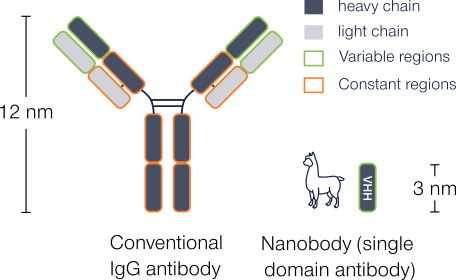
Each FluoTag® carries a defined number of fluorophores at known positions, resulting in quantitative and highly reliable readouts across all fluorescence-based analyses. Compared to traditional monoclonal IgG antibodies, single-domain antibodies from NanoTag Biotechnologies are not only high-affinity and monoclonal, but also monovalent, meaning they bind a single epitope — minimizing crosslinking, aggregation, or artificial clustering of target proteins.
... and brighter!
Our abberior STAR fluorescent dyes were designed to meet the specific requirements of the Stimulated Emission Depletion (STED) microscopy. They cover a broad spectral range from blue (432 nm) to red (638 nm), with dyes providing bright, sharp, and background-free staining, ensuring exceptional imaging quality.

Smart Secondaries® for species independent multiplexing
Monoclonal FluoTag®-X2 secondary nanobodies (Smart Secondaries®) are a set of single-domain antibodies (sdAbs) that recognize conventional immunoglobulins with exceptional species and isotype specificity. Beyond their remarkable precision, these reagents open up powerful new possibilities such as one-step indirect immunofluorescence and effortless species-independent multiplexing.
The Smart Secondary® sdAb recognizes the Fc domain on the respective primary antibody and is decorated with two fluorophores. Due to the inherent symmetry of the target antibody, two secondary nanobodies will be able to bind each primary antibody. Our monoclonal FluoTag®-X2 abberior STAR reagents will therefore target 4 fluorophores to each primary antibody.
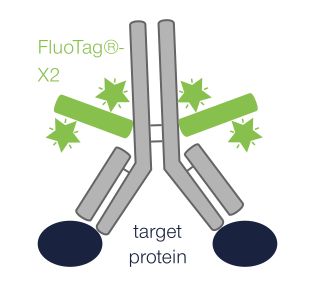
FluoTag®-X2 nanobodies binding to the Fc region of an IgG molecule. Two nanobodies, each carrying two fluorophores, can bind to a single primary antibody, resulting in a total of four fluorophores per primary antibody.
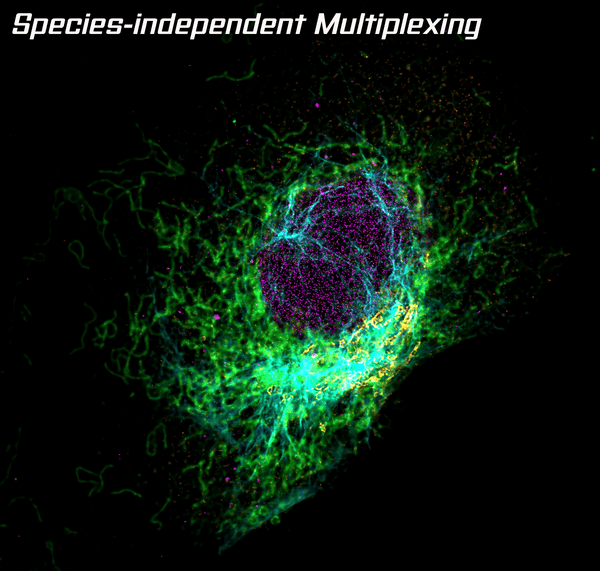
PFA-fixed mammalian cell stained by using Smart Secondaries® from NanoTag Biotechnologies. Stained structures are intermediate filaments (cyan), mitochondria (green), golgi (orange) and nuclear pore complex (magenta).
With our new abberior STAR dye-coupled Smart Secondaries®, you can experience next-level flexibility and precision in your staining workflows. Our advanced multiplexing immunofluorescence technology empowers researchers to stain a single tissue sample with multiple primary antibodies from the same species and isotype—simultaneously. This streamlined one-step immunofluorescence method is what we refer to as "Premix & Stain" (see figure below). Whether you're working with monoclonal mouse IgG1 antibodies or polyclonal rabbit antibodies, our solution enables seamless co-detection—no species switching, no compromise on specificity.

-
Unmatched specificity for reliable results
Smart Secondaries® offer exceptional species and isotype specificity by targeting the Fc domain of conventional antibodies with single-domain nanobodies—ideal for high-precision applications. -
Superior signal intensity
Each primary antibody binds two nanobodies, each carrying two fluorophores, delivering a total of four fluorophores per antibody for enhanced brightness and image quality.
-
Effortless, species-independent multiplexing
Designed for one-step immunofluorescence and compatibility across species, FluoTag®-X2 Smart Secondaries® enable flexible, species-independent multiplex imaging workflows.
Save time, conserve precious samples, and accelerate your insights with a platform designed for high-throughput, high-resolution discovery!
Optimal solution for detecting GFP-tagged proteins with STED
FluoTag®-X4 anti-GFP is a carefully optimized blend of two high-affinity, monovalent single-domain antibody (sdAb) clones (#1H1 and #1B2), each targeting a distinct epitope on GFP. Each sdAb is conjugated to two abberior dyes, resulting in a total of four fluorophores per GFP molecule—providing significantly increased signal intensity.

GFP-boosting nanobody FluoTag®-X4 anti-GFP binding to a GFP and a range of its derivatives. The mixture of two clones (#1H1 and #1B2) allows signal amplification enhancing brightness and detection sensitivity.
Confocal and STED images of PFA-fixed U2OS-NUP96-GFP stable cell line stained with FluoTag®-X4 anti-GFP abberior STAR RED. FluoTag®-X4 anti-GFP specifically binds to GFP fused to NUP96, enabling the visualization of the fine structure of nucleoporins within the nuclear pore complex (NPC) in the STED image.
-
High-affinity binding to GFP and a broad range of its variants
Including EGFP, mEGFP, Sirius, tSapphire, Cerulean, eCFP, mTurquoise, acGFP, Emerald, superecliptic pHluorin, paGFP, superfolder GFP, eYFP, mVenus, and Citrine. -
Small molecular size (3 nm; 15 kDa)
Enables excellent penetration into dense cellular environments, efficient labeling of thick specimens and reduced staining artifacts. -
Signal amplification
Two FluoTag anti-GFP sdAb clones targeting distinct epitopes. Each sdAb carries two fluorophores, yielding four fluorophores per GFP molecule for enhanced signal intensity.

.png?width=1000&height=494&name=Fluorescence%20Image%20anti-GFP%20(NUPs).png)